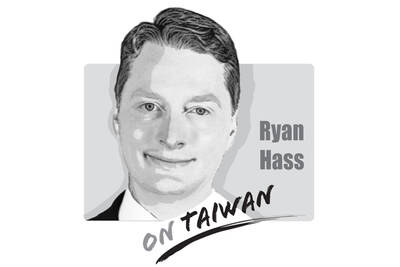President Ma Ying-jeou (馬英九) won the presidential election by playing the economy card. Many of his promises, such as increasing economic growth to 6 percent, or cutting the rate of unemployment to 3 percent, were criticized as impossibilities during the campaign since Taiwan has little chance of beating the odds when the international economy is sluggish. Ma’s government also faces challenges from inflation and soaring commodity prices. However, the Achilles’ heel of his government is not his impossible economic promises, but the fact that the direction of his economic policy is mistaken.
If the government pursues these policies, it will increase deindustrialization and unemployment, reduce consumers’ real income, erode the middle class and increase the number of poor. Civil unrest and public discontentment will follow.
Ma’s thinking follows typical neoliberal economic and globalization ideas: the government should intervene in and administer markets as little as possible in order to create a single globalized free market to facilitate global pillaging by trans-national corporations. His so-called “opening” is really privatization and deregulation aimed at allowing markets to operate freely.
Neoliberalism has always insisted that the government must not intervene in markets because markets are all-powerful, and can automatically resolve their own problems.
Ma believes that all market intervention by the government is a form of containment. However, Ma’s theory is immoral: he considers all governmental policies regulating markets in order to care for the welfare of the lower and middle class as a form of “containment,” “isolationist” and not “open.”
This purposeful misleading by sleight-of-word is not presidential behavior.
Many top economists have long claimed that there are a multitude of problems connected to neoliberal economic globalization. The theory has been in practice since the early 1980s, and its mainstays are deregulation, completely liberalized markets, privatization of all industries — including government-owned firms — and the reduction or cancellation of social welfare payments.
Argentina’s painful experiences serve as an example. In the 1990s, the IMF and the World Bank named Argentina the paragon of developing nations. To accede to the demands of those two institutions, Argentina greatly deregulated its economy, lowered tariffs, privatized government enterprises and cancelled many social welfare measures. Initially, the economy did indeed improve.
However, after more demands from the IMF in 2000, Argentina’s economy quickly collapsed. This, along with social unrest, led the Argentine president to declare national bankruptcy and admit that neoliberal economic globalization had destroyed his country.
A M-shaped society is emerging around the world, including in Europe and North America. Many academics believe this is the result of globalization. Premier Liu Chao-shiuan (劉兆玄) has admitted the beginning of a M-shaped society in Taiwan and listed the strengthening of the middle class as a priority.
Solving the problems caused by a M-shaped society and strengthening the middle class are not goals that can be achieved through more globalization, but by more comprehensive regulations to curb trans-national corporations’ plundering.
Ma and Liu obviously do not get this point. Massive deregulation will not invigorate the public, but corporations. Is Ma’s public made up entirely of corporations?
If the government truly wants to strengthen the middle class, then it shouldn’t deregulate. It must focus on how to keep industries and their investments in Taiwan, rather than hollowing out the country.
Allen Houng is a professor at National Yang Ming University.
TRANSLATED BY ANGELA HONG

China has not been a top-tier issue for much of the second Trump administration. Instead, Trump has focused considerable energy on Ukraine, Israel, Iran, and defending America’s borders. At home, Trump has been busy passing an overhaul to America’s tax system, deporting unlawful immigrants, and targeting his political enemies. More recently, he has been consumed by the fallout of a political scandal involving his past relationship with a disgraced sex offender. When the administration has focused on China, there has not been a consistent throughline in its approach or its public statements. This lack of overarching narrative likely reflects a combination
US President Donald Trump’s alleged request that Taiwanese President William Lai (賴清德) not stop in New York while traveling to three of Taiwan’s diplomatic allies, after his administration also rescheduled a visit to Washington by the minister of national defense, sets an unwise precedent and risks locking the US into a trajectory of either direct conflict with the People’s Republic of China (PRC) or capitulation to it over Taiwan. Taiwanese authorities have said that no plans to request a stopover in the US had been submitted to Washington, but Trump shared a direct call with Chinese President Xi Jinping (習近平)
Father’s Day, as celebrated around the world, has its roots in the early 20th century US. In 1910, the state of Washington marked the world’s first official Father’s Day. Later, in 1972, then-US president Richard Nixon signed a proclamation establishing the third Sunday of June as a national holiday honoring fathers. Many countries have since followed suit, adopting the same date. In Taiwan, the celebration takes a different form — both in timing and meaning. Taiwan’s Father’s Day falls on Aug. 8, a date chosen not for historical events, but for the beauty of language. In Mandarin, “eight eight” is pronounced
Heavy rains over the past week have overwhelmed southern and central Taiwan, with flooding, landslides, road closures, damage to property and the evacuations of thousands of people. Schools and offices were closed in some areas due to the deluge throughout the week. The heavy downpours brought by the southwest monsoon are a second blow to a region still recovering from last month’s Typhoon Danas. Strong winds and significant rain from the storm inflicted more than NT$2.6 billion (US$86.6 million) in agricultural losses, and damaged more than 23,000 roofs and a record high of nearly 2,500 utility poles, causing power outages. As